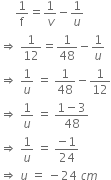(a) Explain the following terms related to spherical lenses:
(i) optical centre
(ii) centres of curvature
(iii) principal axis
(iv) aperture
(v) principal focus
(vi) focal length
(b) A converging lens has focal length of 12 cm. Calculate at what distance the object should be placed from the lens so that it forms an image at 48 cm on the other side of the lens.
ii) Centre of curvature: The centre of sphere of which a part of lens is formed is called the centre of curvature of the lens.
Concave and convex lens has two centre of curvature because they are formed by the combination of two parts of sphere. One centre of curvature is denoted by C1 and second is denoted by C2.
iii) Principal axis: The line passing through the optical centre of the lens and perpendicular to both faces of the lens is known as the principal axis.
iv) Aperture: Aperture is the diameter of the sphere of which a lens is formed.
v) Principal focus: The point at which a ray after refraction or reflection converges in a convex lens and mirror respectively is known as the principal focus.
The point at which an incident ray after refraction or reflection appears to diverges on the principal axis in a concave lens and concave mirror is known as principal focus.
vi) Focal length: The distance between the optical centre and principal focus of the lens is known as the focal length.
Image distance, v = +48 cm
Focal length, f= +12 cm
Object distance, u = ?
Now, using the lens formula,

Thus, the object should be placed at a distance of 24 cm from the convex lens.





